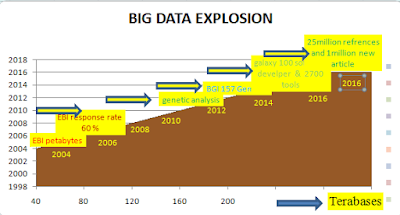Big data in natural sciences:
Big data is an excogitate phrase that describes any prolific amount
of painstaking and un painstaking data that has the conceivable
for information to become a crucial basis of
competition, underpinning new waves of productivity growth is difficult
to process using traditional database and software techniques.
 |
Big Data challenges in natural sciences |
Biological
exploration in the information age is immensely aggressive whether in an
academic, government
or a commercial setting. Staying current with the gospel relevant to
an appropriate research area can be very difficult, but understanding
with multiplex biology
is often critical
to accomplish key research goals – so researchers need every advantage
they can get. The
difference acquire access to the right answers
and not acquire it could be a failed
grant application,
a forsaken publication In most establishment scenarios
the volume of data is too big or it moves too fast or it exceeds current
processing capacity and potential help to companies to revamp operations and
make agile, more intelligent decisions.
The data is composed from a number of commencement of biology
like bioinformatics in which Data
mountains and analysis are revamping the way evolution and rearing the biologists
who get neither their feet nor their hands wet
also like to used different databases to complete their work basis on
establishment of big data and databases like BGI, NGS, Galaxy, NIH, OMIM,
PubMed and cloud computing are large data sets are processed on remote
Internet servers rather than on researchers so large data can achieved by multi
user to do different task in biology therefore this
data can be conquer, formatted, wield, stored and then analyzed with huge
amount that can help a different organization to gain useful intuitiveness to
increase revenues to get or recognize customers and improve Storing and interpreting.
Big data
takes both real and virtual bricks and mortars are much of the virtual
construction in which data and software are situated and users can achieve on
demand, so that they do not need to purchase self-hardware and maintain it on
site operations. Data- demanding techniques, now widely
referred to as big data allow for unique ways to address complexity in science.
Big-data
science is very from other deductive uses of information technologies like to prefers
computer simulations that used to sketch the multiplex and contextual nature
established by dispelling the popular myth so big data is concerned with modeling
in data-intensive science that lead to characterized as hierarchical and nested
structure familiar from more conventional approaches
has recently become a “big-data science” mainly supported by the advances in
high-throughput experimental technologies.
Figure: Summary of data distribution considered a challenge in every year
Data-intensive
science consists of commandeer, establishment, analysis and research that encapsulate with more than
25 million references in PubMed, and over
1 million new articles being published every year may cause challenge in life
science to manage data so researchers devastate trying to find the specific
information they need from the scientific
literature to enable their research. Advances in
Next Generation Sequencing (NGS) technologies allow us to generate data at remarkable
speed at whole genomes and whole transcriptomes instead of at the single gene
level so this technology not only impacts on research, but also involve how medical
care is provided. However, the biggest challenge for utilizing the power of
such data is our limited ability to quickly and reliably obtain insights from
this data.
Science
is going rapidly changing in increasing capabilities of the computers and
software tools used to handling big data raise many new researches challenges
to pursue in systems biology genomes, transcriptomes, proteomes, metabolomes,
interactomes so on and big data challenges are not only their size but also
their increasing intricacy or datasets
is driving the advancement of new technologies for finding items of attentiveness
in data from DNA sequencing.
Bioinformatics has become an active area
of research in the supercomputing community and become a data intensive science and as a consequence
biology and computer science have become complementary to each other bridged by
other branches of science such as statistics, mathematics, physics, and chemistry.
The
combination of versatile knowledge has caused the advent of big-data biology,
network biology, and other new branches of biology facilitate the system-level understanding
of the cell or cellular components and sub processes. The purpose of this field
is to understand organisms or cells as a whole at various levels of functions
and mechanisms facing the challenges of analyzing big molecular biological data
and huge biological networks.
This summary gives an overview of the progress in big-data biology, data handling, challenges in new interface and also introduces some applications of health networks DNA, RNA platforms and multivariate analysis in systems biology.
Big challenges of big data in natural sciences
About Author
Mr. Imran Zafar
has completed his Bachelor of Science (BS) degree in Bioinformatics from
COMSATS Institute of Information Technology Islamabad Sahiwal campus under
supervision of Dr. Ahmad Ali and Master of Science (MS) in Bioinformatics from
Department of Bioinformatics and Computational Biology, Virtual University of
Pakistan, Lahore, Punjab, Pakistan under supervision of Dr. Muhammad Tariq
Pervez. For research work during BS and MS he has also done internships from
School of Biological Science (SBS), University of Veterinary and Animal Sciences (UVAS) and Center of Excellence in molecular
biology (CEMB) Lahore. He has published several research articles and book
chapters in reputed journals recognized from Higher Education Commission (HEC)
of Pakistan. His research is mainly
focused on the field of Bioinformatics, Genomics, Computational Biology and
Molecular Biology in the domain of life science to performed computational
analysis. He is now working in Ministry of Education as a Science subject
instructor in the Department of Education Punjab, Pakistan.






No comments:
Post a Comment